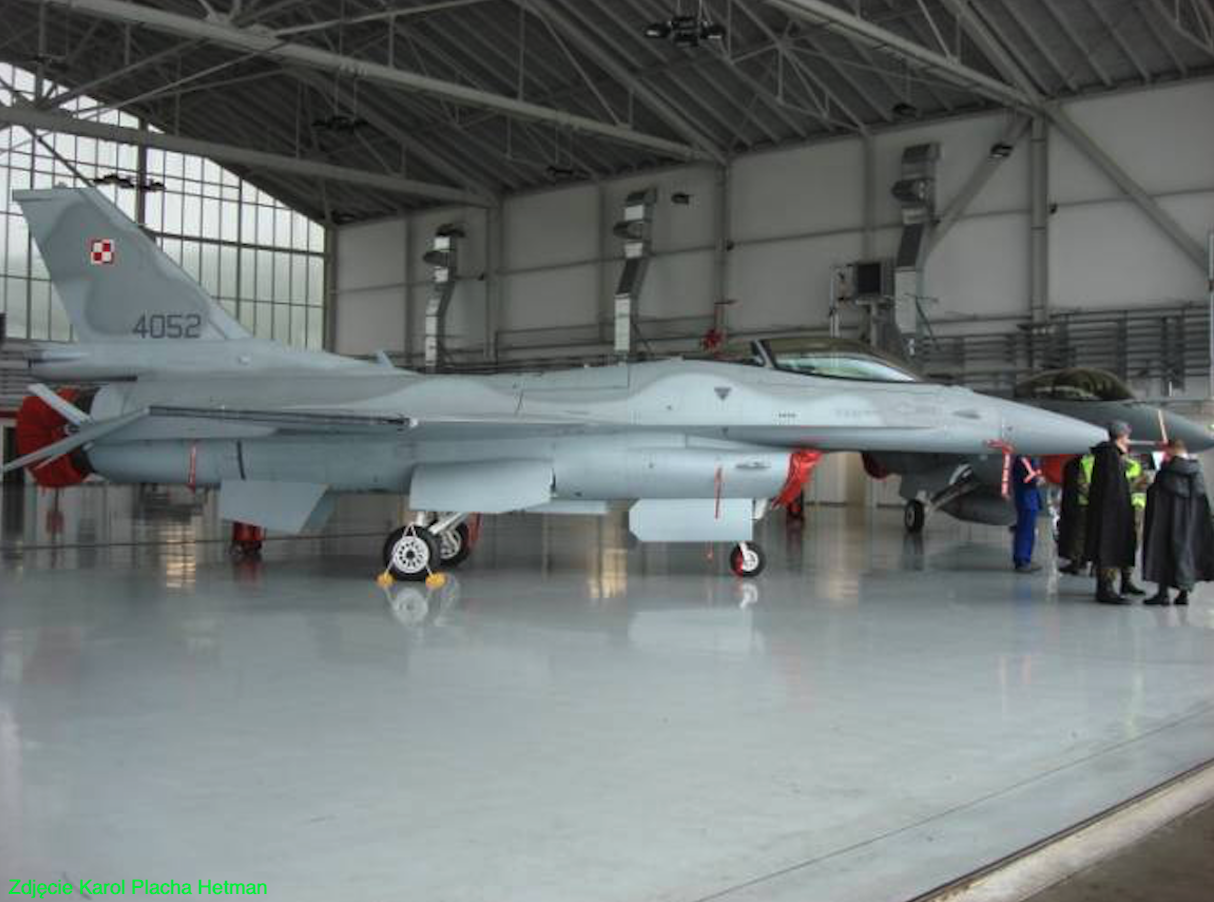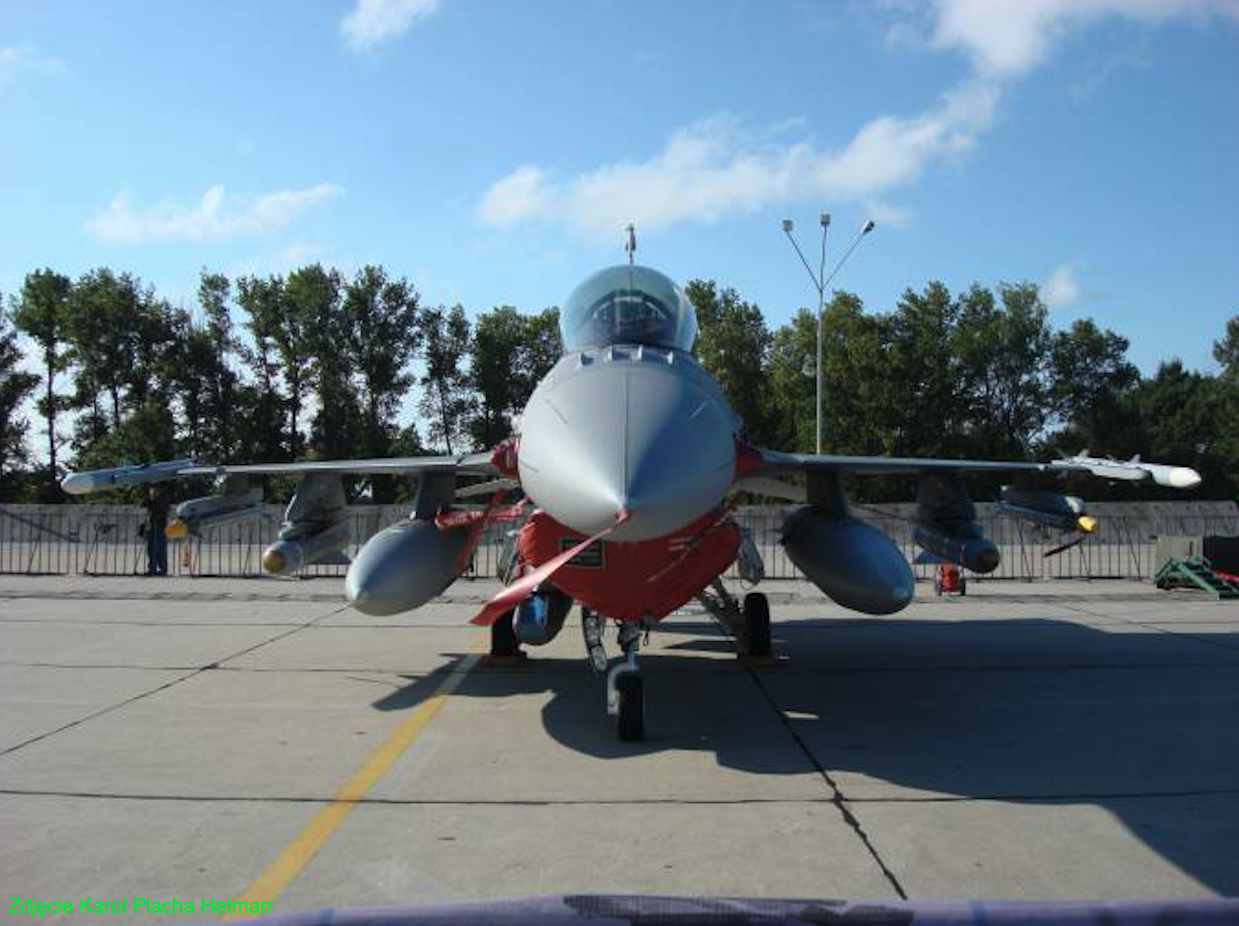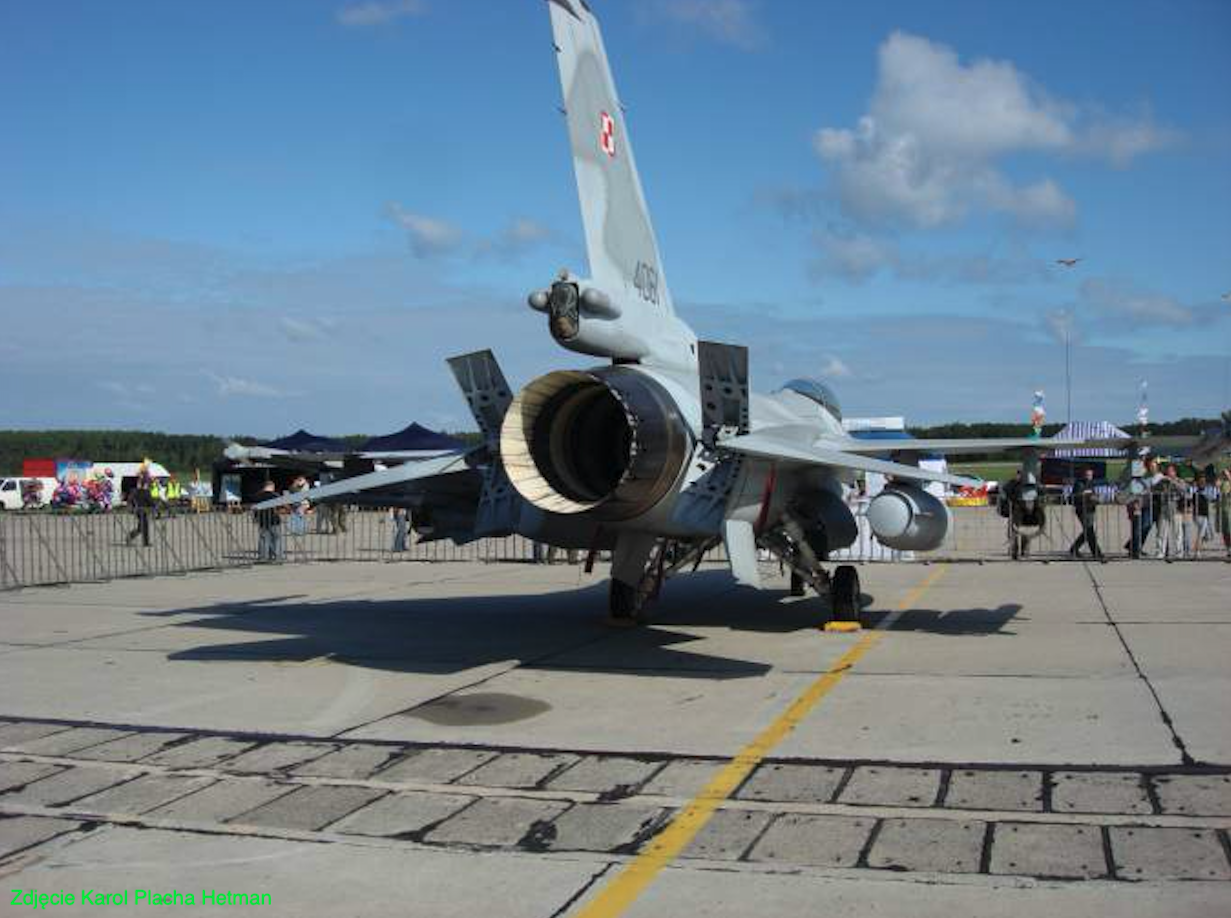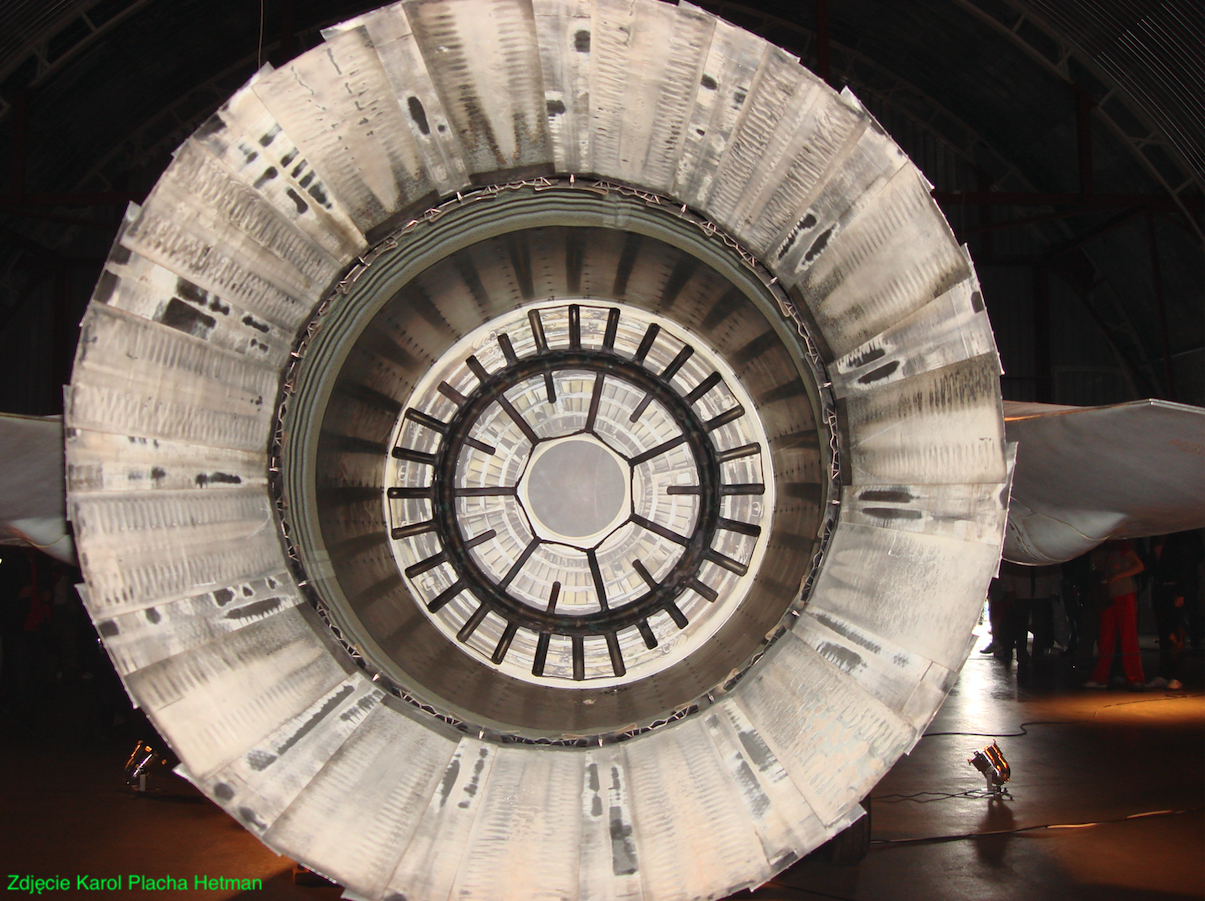Kraków 2005-05-16
Lockheed Martin F-16 C, D Advanced Block 52 + Jastrząb.
315 Section 2006-11-08 Poland.
Construction
Construction F-16 C, D Advanced Block 52 + Jastrząb.
The F-16 multi-role combat aircraft is a single- or two-seater, single-engine medium wing aircraft. It was built in a classic layout. Multi-role with increased possibilities of air combat and attacking ground targets, also at night. The structure of the airframe is designed to withstand overloads of +9g, -3g.
The wings are trapezoidal in outline, NACA 64A-204 profile, leading edge bevel 40 degrees, no rise. The elongation of the wing is 3.2, the wing area is 27.87 m2. The structure is multi-girder, two-part, half-shell, of the safe destruction type. It consists of 11 girders and 8 split ribs, including 4 reinforced ones, to which hardpoints are mounted. The girders start with milled flange-type fittings used for mounting the wings to the fuselage. The cover of the wings is made of single sheets of metal. The inside of the wing was used for fuel tanks. On the leading edge, hatches of sandwich construction with honeycomb filler were installed, with an area of both 3.41 m2. On the trailing edge, flap-ailerons, also of sandwich construction with a honeycomb filler, were installed. They cover 80% of the wing span and are mutually interchangeable. Both parts have an area of 2.91 m2.
The aircraft’s fuselage is of a modular, semi-monocoque, metal construction, of the safe destruction type. The fuselage is partly of the load-bearing type, therefore when we talk about band wings of this structure, we mean the side parts of the fuselage capable of generating lift. Technologically divided into 3 parts and an air intake module. The front element houses the radar station, the pilot’s cabin (pilots), the front fuel tank, the cannon with the ammunition drum. The middle module consists of 24 stringers and 8 strength members. The chassis together with the chassis chambers is attached to this element. Inside, there is also an air duct and fuel tanks, and a device for refueling in flight on the back. The rear part of the fuselage consists of two side jibs ended with crocodile brake flaps, with a maximum inclination of 60 degrees. The booms are connected to the top above the engine and supplemented with lower reinforcements, to which the landing hook is also attached. Sealed, air-conditioned cabin. A switchboard equipped with 3 screens (cathode monitors) supplemented with a translucent indicator. Traditional instruments have been reduced to a minimum and serve as an emergency. Under the dashboard, there are those elements of equipment that require air-conditioned conditions. Aces II type 0-0 ejection seat, tilted by 30 degrees, for better handling of the overload by the pilot. The cabin glazing is made of a single sheet of 14-layer polycarbonate. The fairing is lifted up to the rear. The glazing is complemented by a small window at the back. Visibility horizontally 360 degrees, vertically 270 degrees is very good. In the cabin, instead of the central stick, a joystick (joystick) was mounted on the right desktop-armrest.
The tail of the plane is classic. Vertical with a slant of 45 degrees, an area of 5.09 m2, a semi-shell structure with 4 girders. Carbon composite cover. Leading edge with sandwich construction with honeycomb filler. A sandwich-composite rudder with a honeycomb filler, suspended in three points and has an area of 1.08 m2. The rudder control elements and some equipment were mounted in the base of the tail. Horizontal plate tail, trapezoidal, with cut ends, with a bevel of 40 degrees and a negative rise of 10 degrees. Structurally made of one titanium girder and an auxiliary duralumin girder. The rest is cellular filling and composite cover. The horizontal tail is mutually alternating. The span of the horizontal tail is 5.60 m, and the area is larger than in the A/B versions – 5.92 m2. The tail is complemented by two trapezoidal aerodynamic steering wheels, 10 degrees apart to the sides. Composite construction with cellular filling.
Three-support landing gear, with single wheels, retractable to the hull. Front on a half-fork, steerable retractable to the rear. Dimensions 0.457 x 0.145, pressure 2.07 – 2.14 MPa. In the main landing gear, disc brakes with an anti-skid system (ABS), retractable forward with a simultaneous rotation of 90 degrees to flatly adhere to the air duct. Dimensions 0.705 x 0.222, pressure 1.45 – 1.52 MPa. Oil-gas shock absorbers in the legs. Chassis base 4.00 m, chassis track 2.36 m.
Rescue system for the pilot.
The primary rescue system for aviators is the 0-0 class ejection seat developed in the mid-70s. It bears the designation Aces II. It was used for the first time in April 1978, on the A-10 battlefield aircraft. Initially, it was produced by McDonnell Douglas, and since November 1999, it has been manufactured by BF Goodrich, which took over the production line from Boeing when it absorbed McDonnell Douglas on August 1, 1997. The seat allows for safe descent of the aircraft in the speed range from 0 km/h to 1,111.8 km/h and from the height of 0 m to 15,240 m. These apparent accuracy results from the conversion of Anglo-Saxon measures into the SI system. After launch, the STAPAC system, i.e. the gyroscopic stabilization system, is responsible for proper operation. In the case of launching at low altitude, the parachute deploys after 1.6 seconds, and at high altitude after 6 seconds from leaving the plane.
F-16 aircraft engine.
The drive is one Pratt & Whitney F-100 PW 229 IPE engine, the maximum thrust of the engine is 1 x 72.0 kN, and 1 x 129.4 kN with afterburning. The first (five) Polish F-16s received engines manufactured at the P&W plant in Middletown. The other engines were built in Poland at WSK PZL-Rzeszów S.A. On March 11, 2002, this plant became part of the American corporation UTC United Technologies, associating companies such as Pratt&Whitney, Hamilton Sundstrand, Carrier, Otis and Sikorsky. On September 28, 2006, the first Polish F-16 with an engine from Rzeszów made a flight. In addition, Poland ordered 7 spare engines and a large package of spare parts for these engines. Other engines can also be used to power F-16 aircraft.
Additional fuel in conformal tanks.
For some Polish Hawks, tanks placed on the side parts of the fuselage, called conformal CTF (Conformal Fuel Tanks) with a capacity of 1,700 liters, were ordered. Flight tests of the F-16 with these tanks began on November 27, 2002, and as a result it turned out that they had a minimal impact on the deterioration of flight characteristics. Their assembly and disassembly takes two hours. They are permanently assigned to a specific aircraft and cannot be interchanged.
Radar.
Polish F-16 aircraft were equipped with the Northrop Grumman APG-68 (V) 9 Radar. The first such radar station (SR) was installed on the Greek F-16 Block 52+ in April 2002. This station is characterized by a 5x increase in memory and a 10x increase in data processing speed compared to the previous SR APG-68 (V) 8. The new SR also has a 33% greater detection range of air targets. In the out-of-sight mode, the SR allows you to simultaneously attack 4 enemy air targets. In the terrain map creation mode, thanks to the use of SAR (Synthetic Aperture Radar) technology, a resolution of 0.6 m was achieved.
Avionics.
Nowadays, the value of an aircraft is increasingly determined by the quality of the avionics equipment installed on it, the heart of which are the processors and the program contained in them. To say that electronics help you fly is a gross simplification. It is true that without computers, no fighter could fly even 100 meters. But the basis is the slogan – "I see first, I shoot first and I kill first". The first element is the control system. In the 1970s, the subject of the modern General Dynamics F-16 Fighting Falcon aircraft control system was extensively written about. the classic control stick has been replaced with a joystick taken alive from television and computer games. In addition, he moved from the center to the side right desktop. But the main side of its modernity was inside, where traditional strings, cables, pushers were replaced with electric wires, processors, sensors and servos. Thanks to the new technology, it was possible not only to relieve the pilot of the controls, but above all to create an aerodynamically unstable aircraft, which means that the electronics constantly watches over the position of the aircraft, making corrections dozens of times per second. The electronics ensures that the aircraft does not get into a dangerous position at an inappropriate speed. The active control system (fly-by-wire) allows the aircraft’s electronics to modify the pilot’s decisions in a way imperceptible to him. On-board computers guess human intentions rather than allow them to actually adjust the position of the tail. Thanks to this, the aerodynamically unstable, but fast and agile plane flies all the time on the verge of disaster, and yet it is easy to steer. For thirty years, the philosophy of controlling the F-16 itself has not changed. However, the capabilities of the system have been improved by uploading newer software, the capabilities of the processors have been increased and its reliability is constantly being improved. From the Block 40 series, the whole process is digital, that is, there are no more analog elements. In the latest version, electric wires have given way to optical fibers. They are also doubled four times, which increases security. It should also be remembered that replacing the traditional control system with a new one reduces the weight of the airframe. The current generation of F-16s, including Polskie Jastrzębie, are distinguished by integrated avionics, which means that everything is connected into one interdependent system; control system, navigation system, weapon system, crew interface system. All avionics are connected by data buses; four MIL-STD 1553B and two MIL-STD-1760 (customized for "smart" bombs). Four computers were installed in the control system. The first one is; Modular Mission Computer MMC 70000 (translating pilot commands into aircraft control signals, navigation, weapon systems management and displaying information on the HUD. Performs 155 million operations per second), Color Programmable Display Processor (manages four multi-function displays that replaced traditional clocks), Digital Flight Control Computer (controls the fly-by-wire system) and Common Data Entry Electronics Unit (operates the pilot’s "keyboard"). Other important computers are Advanced Identification Friend Or Foe (identifies encountered planes) and Electronic Warfare (defends the plane against missiles). Modular Mission Computer consists of several 32-bit MIPSCO R3000 processors and has 60 MB of RAM at its disposal. Packed with electronics, the machine gained the unofficial nickname "Electric Jet". Software languages were used in the plane’s systems; C++, Visual Basic, ADA, Joviala and machine language. The F-16 can transmit information both to other aircraft and to ground stations. All this thanks to the Data Link-16 system. The device uses the UHF 969 – 1,206 MHz band and is compliant with the NATO MIDS (Multufunction Information Distribution Systems) standard.
The avionics teams include; Integrated GPS/INS navigation system (GPS satellite navigation system). The F-16 was one of the first combat machines in the USAF aviation equipped with GPS. TACAN/DME system, close navigation system. MMR/ILS system, landing system. MDR-80 digital video recorder (Mission Date Recoder). Produced by TECA Aerospace Technologies, it measures 14.9 x 12.2 x 16.2 cm and weighs 3 kg. It records video (MPEG-2), audio, and information from other aircraft systems. In the basic version, it is equipped with a 24 GB memory. AN/APN-232 CARD (Combined Altitude Radar Altimeter) radio altimeter. Its accuracy depends on altitude and is +/- 2 feet from 0 to 100 feet, +/- 2% from 100 to 5,000 feet, +/- 100 from 5,000 to 10,000 feet, and 1% above 10,000 feet. 1 foot = 0.3048 m. The IFF APX-113 transponder is used to identify aircraft. Communication is provided by two Honeywell AN/ARC-238 radios. they operate in two bands UHF and VHF. Each has two XM 6912 and XM 6913 transceiver modules, supplemented with the Have Quick II encryption panel. ALR-56 M warning station. An integrated self-defense system has been installed on the aircraft, warning about radiation of the aircraft with a radar beam, laser beam or infrared rays, AN/ALQ-211 (V) 4 AIDEWS (Advanced Integruted Defens EW System, its manufacturer currently uses a new name Suite of Integrated RF Countermeasures). In the years 1998 – 2000, the system underwent operational trials, after which it began to be installed on Apache D helicopters equipped with the US Army. Chile and Oman also chose it for their F-16s. The AIDEWS system works closely with AN/ALE-47 flare and dipole launchers and towed decoys to defend against AN/ALE-50 AAED (Advanced Airborne Expendable Decoy) missiles. Decoys developed by Raytheon have been used by the USAF on the F-16 since 1996, and are mounted two by two on the launcher-controller via a special pylon at the ends of the wings, at the trailing edge. Currently (2005), the manufacturer is implementing the tenth batch of orders, after which the number of lures delivered will amount to 23,365 pieces. AN/ALE-50 systems are also used on B-1 B and F-18 E/F aircraft.
Looking at the next generations of F-16s hidden under Block numbers … we do not see many differences in aerodynamics, which means that fundamental changes were made in the interior and in the avionics. The F-16 was the first aircraft adapted to the use of "intelligent" JDAM bomb systems. The "upgrade" of several hundred older versions of the F-16 currently being implemented (2005) in the USAF boils down to replacing the main computer, installing advanced target identification systems, modernizing the on-board data bus, and installing a viewfinder on the helmet and an electronic artificial horizon. Some of the components are specially designed systems, but a lot – and more and more – are components available in stores.
Here we come to the matter of the software itself. As soon as the combat value of the F-16 Block 40 version has increased through the new software, what will the software for our F-16 aircraft look like in the future? Will we be able to obtain access codes, or will we be able to develop new programs ourselves? As it turned out, the United Arab Emirates, when buying the F-16 Block 60, got the source codes for their machines.
A small digression here. The UAE and Israel were given the opportunity to purchase the most modern version, Block 60 (more powerful engine, more efficient computers, fiber optic buses, more efficient radar station. But on the other hand, we must remember that they are constantly fighting for their lives in real combat operations. Our Hawks meet WTT ( tactical and technical requirements) set by the Polish side, so everything is good.
A helmet-mounted Joint Helmet-Mounted Cueing System (JHMCS), thanks to which the pilot will be able to select missile targets simply by looking at the enemy plane, without having to direct the nose of his own machine. In general, the system is similar to what the MiG-29 has. He collaborates with the short-range AIM-9 X Sidewinder cash register and with precision armament, enabling the destruction of ground targets, using SR and FLIR and a TV camera of the aiming pod. By 2004, Boeing had delivered over 1,500 kits to the air forces of 15 countries. The system is integrated with the F-16, F-15 and F-18 aircraft. During night missions, Polish pilots will have Night Vision Goggles AN/AVS-9 (V) 3 at their disposal. Depending on the type and type of aircraft, the manufacturer offers 40 goggle configurations. The AN/AVS-9 field of view is 40 degrees, and their weight reaches 550 grams. In the cabin, all displays are in color. In the Block 50 version, half were monochrome. "Marking information on the display with different colors allows the pilot to assess the situation more quickly" – says Major John Breazeale of the US Air Force’s 85th Test Squadron. Interestingly, unlike PC LCD displays, panels on fighters are as readable in the dark as in sunlight. When discussing the elements of the Jastrzębie’s optoelectronic equipment, two suspended pods should be mentioned. The first is the Lockheed Sniper ATP (Advanced Targeting Pod) produced by the company. This aiming pod with a diameter of 0.30 m and a length of 2.39 m, weighing 181 kg, consists of a third-generation FLIR, a laser that acts as a rangefinder and target highlight marker, a CCD-TV television camera. The field of view is 4 degrees and 1 degree in close-up mode, and can vary from +35 degrees to -155 degrees. Containers suspended under the fuselage with the LANTIRN digital navigation and target guidance system. The Yankee F-16s did not have such devices during the first Iraq war, which was the reason for their surprisingly poor effectiveness during bombing missions.
Reconnaissance pods.
PSP also purchased seven Goodrich DB-110 reconnaissance pods. The pod enables reconnaissance both during the day and at night. Equipped with cameras with a double-stabilized zoom telescope. Nominal values are 279.4 cm and 139.7 cm for the infrared mode. The field of view is 180 degrees, with the ability to zoom from 4 degrees to 28 degrees. The pod operates in the Ma-0.1 to Ma-1.6 speed range and in the altitude range from 3,000 m to 24,384 m. The image from the pod can be displayed on the MFD panel in the aircraft cabin, as well as in real time to the ground station. Poland has two such positions. These tanks are used in the RAF aviation on Tornado aircraft, in Japanese aviation on P-3 Orion aircraft. The first flight of the Jastrzębie with such a container took place on January 16, 2007 at Edwards Base.
F-16 Jastrząb aircraft painting.
Polish F-16s were painted in three shades of grey; FS 36118, FS 36270, FS 36375. Chessboards with dimensions of 0.30 x 0.30 m (white FS 37875, red FS 31350). The varnish coating is made of special Have Glass paints that reduce the effective reflection surface by 15%.
Armament.
M-61 A 1 Vulcan cannon, 6-barrel, 20 mm caliber. Constructed in the 1950s and widely used since 1959. Dimensions; length 1.87 m, weight 120 kg, the muzzle velocity of the projectile is 1,040 m/s, the basic rounds are high-explosive incendiary PGU-28.
AIM-9X Sidewinder. This version had its first test firing in 1999, and production was started in 2004. The next-generation passively guided warhead, thanks to the HOBS (High Off-Bore Sight) system, works with JHMCS. The missile uses the LAU-7 and LAU-12 X launchers. Missile dimensions; length 3.0 m, diameter 12.7 cm, span of front stabilizers 35.31 cm, span of rear stabilizers 44.45 cm, weight 85 kg.
AIM-120C-5 AMRAAM. The first missiles were delivered to the military in 1988, replacing the AIM-7 Sparrow missiles. Version C has been produced since 1999. Active control. The missile uses the LAU-129 E/A launcher. Dimensions; length 3.65 m, diameter 17.8 cm, front tail span 44.5 cm, rear tail span 44.7 cm, weight 161.5 kg, warhead weight 20.5 kg.
AGM-65 G2 Maverick. The first test firing of the missile took place in 1972 and was controlled by television. The version purchased by Poland is infrared controlled, like most variants of this missile. The FMK-135 B missile warhead contains 135 kg of explosive. The missile uses the LAU-117 launcher. Bullet dimensions; length 2.49 m, diameter 30.5 cm, wingspan 72 cm, weight 304 kg.
AGM-154C JSOW. The first firing of the F-16 took place in 1996, and production began in 1999. It is a gliding bomb, with or without a drive, guided by GPS/IMS. Version C has an additional infrared sensor. The missile uses the BRU-55/57 launcher. Missile range without propulsion; from an altitude of 1,524 m, it is 22 km, from an altitude of 12,192 m, the range is 130 km. Range with drive 290 km. Bullet dimensions; length 4.10 m, weight 475 kg.
Mk-82 bomb. length 2.21 m, weight 227 kg.
Mk-84 bomb. length 3.72 m, diameter 45.7 cm, weight 907 kg. The explosive is tritonal, a mixture of 80% TNT and 20% aluminum powder. The explosive power is 18% greater than that of pure TNT.
The bombs can be equipped with a JDAM, a tail wedge equipped with fins, and an inertial navigation system combined with GPS. Overlays since 1998 manufactured by Boeing. This makes the bombs extremely precise. The accuracy of the hit is 14 m. The costs are much lower, because such a bomb costs $21,000, and a Maverck missile as much as $270,000. Mk-82 bombs with overlays were designated GBU-38 and Mk-84 bombs were designated GBU-31.
GBU-22, GBU-24 Paveway III are sets consisting of a laser head and a cap with four stabilizers, for Mk-82 and Mk-84 bombs.
Data T-T F-16 C/D Block 52+. 2006 year:
Span 9.45 m. Length 15.03 m. Height 5.09 m. Bearing area 27.90 m2. Curb weight 8,870 kg. Maximum weight 19,185 kg. Cargo weight 5,435 kg. Fuel 3,935 liters 2,570 kg. Maximum speed 2.2 Ma. Top speed 2,700 km/h. Maximum speed at 0 m 1,472 km/h. Climb speed 320 m/s. Landing speed 230 km/h. Maximum range 4,472 km. The radius of action is 530-800 km. Pratt & Whitney F-100-PW-229 engine, thrust 1 x 72.0 kN w/o, 1 x 129.4 kN w/o The operating cost per 1 hour of flight is PLN 43,000 in 2006.
Written by Karol Placha Hetman




